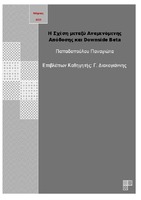Η σχέση μεταξύ αναμενόμενης απόδοσης και Downside Beta

Προβολή/
Θεματική επικεφαλίδα
Portfolio management ; Finance ; Stocks -- Prices ; Stock price forecasting ; Rate of return ; Μετοχές -- Τιμές ; Χρηματοδότηση ; Διαχείριση χαρτοφυλακίουΠερίληψη
Η μελέτη της σχέσης αναμενόμενης απόδοσης και κινδύνου αποτελεί μια από τις σπουδαιότερες προκλήσεις των ερευνητών, από το 1952 οπότε και ο H.Markowitz θεμελίωσε τη σύγχρονη θεωρία χαρτοφυλακίου. Μέχρι και σήμερα, τόσο σε ακαδημαϊκό επίπεδο όσο και σε εφαρμοσμένο κυριαρχούν τα υποδείγματα ισορροπίας που βασίζονται στο περιβάλλον μέσου- διακύμανσης (Expected return-Variance ή E-V), λόγω της απλότητας τους. Εντούτοις, το 1979 ο H. Markowitz αναγνώρισε ότι, το πλαίσιο ανάλυσης μέσου και ημι-διακύμανσης, παρουσιάζει σημαντικά πλεονεκτήματα σε σχέση με το περιβάλλον E-V. Σκοπός της παρούσας εργασίας είναι η θεωρητική και εμπειρική μελέτη της ανωτερότητας των downside μέτρων κινδύνου, έναντι των παραδοσιακών. Στο πλαίσιο αυτό πραγματοποιείται ανάλυση των θεωρητικών ευρημάτων της επιστημονικής βιβλιογραφίας, καθώς και τα ευρήματα εμπειρικών μελετών. Η μελέτη αφορά στην εξέταση της σχέσης αναμενόμενης απόδοσης και κινδύνου των μεμονωμένων μετοχών για τις αγορές του Ηνωμένου Βασιλείου, της Γερμανίας και της Γαλλίας, για εισηγμένες μετοχές την περίοδο 1993-2013. Η μελέτη αφορά τη σχέση της αναμενόμενης απόδοσης με δύο μέτρα συνολικού κινδύνου, την τυπική απόκλιση και την semideviation των αποδόσεων, και δύο εναλλακτικά μέτρα συστηματικού κινδύνου, τον συντελεστή beta και το downside beta, με τη μέθοδο ανάλυσης παλινδρόμησης, αλλά και την ανάλυση ανά ζεύγη και όλων μαζί.


